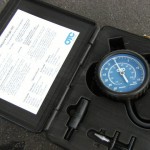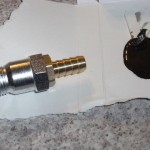So I've talked before about how you measure intake restriction and how you can actually find the source of restriction by using a differential pressure meter. However, while I've alluded to the fact that you can also do something similar for exhaust back pressure, I haven't done anything about it until now.
 Today I want to share with you how you can analyze an existing (or aftermarket) exhaust system using a very inexpensive gauge, some tubing, a spark plug defouler, some jb weld and a fitting from your local home hardware store. It's like tuner MacGyver, but trust me, it works great.
Today I want to share with you how you can analyze an existing (or aftermarket) exhaust system using a very inexpensive gauge, some tubing, a spark plug defouler, some jb weld and a fitting from your local home hardware store. It's like tuner MacGyver, but trust me, it works great.
The grand total of the project might run as much as $40-60 or so but you probably have most of what you need lying around.
Most enthusiasts know that reducing backpressure in the exhaust system will typically yield a performance gain. However, there is much speculation about what exactly makes a big difference and what does not. Sure, a bigger pipe will almost always reduce backpressure as will a higher flow muffler with either a straight through or significantly less baffled design.
But what about the catalytic converter, is it really a restriction in your application? On some cars it may be a huge restriction, while on others it doesn't seem to make much difference. What about the resonator? Is it really causing any back pressure at all? Is the back pressure mostly coming from the cat back? or is it just from the axle back?
Knowing where in the system the restriction is can be useful if you're on a budget, or, if you're trying to get the most power out of your system and want to identify areas of additional improvement without excessive cost.
Like the intake restriction measurement technique I've described elsewhere on the site, the methods that I want to tell you about today allow you to pinpoint EXACTLY where the restrictions are.
Today I'm just going to talk about how you test an existing system (and perhaps the modifications you make after that). In other words, how to figure out where restrictions are in the stock system, and how to measure changes in backpressure caused by modification you make. In a later article, I'll explain how you can actually test mufflers, resonators and cats OFF the car so that you can locate a very nice flowing cat, muffler, or resonator at the junk yard or exhaust shop in case you might want to use junk yard parts to create a great inexpensive sleeper performance exhaust system.
First, some bad news
Bad news is, it's very difficult to get pinpoint accurate back pressure measurements because exhaust pressures are pulses, not constants. In other words, because exhaust gasses go back and forth up and down the extractors and exhaust system VERY fast, you will get a very bouncy needle on the vacuum gauge we use to measure back pressure.
Good news is, it really doesn't matter much because you're going to be mostly interested in the "peak" number and you're also going to be looking for BIG changes, not tiny ones, so the measurement still works out quite well. Just know you'll probably have to have a friend help you when you go out to take measurements.
Now lots of good news
Measuring back pressure is not rocket science. As a matter of fact, the hardest part is either finding a good place to tap into the exhaust system and how to keep tubing from melting. Aside from that, it's no big deal. Fortunately, the difficult parts I've already solved for you.
The first thing you need is a pressure gauge that can read up to about 20psi. They sell these at auto parts stores and many can read vacuum as well. For exhaust back pressure, I prefer mechanical gauges because they're generally cheaper to replace and less delicate.

Spark plug defouler (purchased from autoparts store) with fitting from hardware store to attach transmission fluid hose.
Next thing you need is a spark plug defouler which conveniently has the same threading as an O2 sensor. Go to the hardware store after you get one of these and find a fitting that will screw into it. I found one at the hardware store that had a similar thread but still fit and used JB Weld to secure the threads and make sure everything was nice and tight.
Then you need transmission line hose. You need this or something rated for even higher temps because the tip of the fitting we made above will get relatively hot, relatively quickly. You also need hose clamps that will allow you to really clamp the hose down onto the fitting or the exhaust backpressure will blow the hose off.
Once you've got these items, run the hose to your fitting, screw the fitting into an O2 bung and the other end of the hose will need to go into the vacuum gauge. No worries if you have to use a few different kinds of adapters to make the connection work, the most important thing is that the line isn't kinked and that the connection is sealed.
Now back to that O2 bung thing. The easiest way to measure back pressure is to find one of the secondary O2 sensors, unscrew it, zip tie it out of the way (or remove from the car), and temporarily plumb in your fitting to take a measurement.
However, the best way is to weld or have an exhaust shop install O2 bungs in the pipe at the locations you're interest in taking measurements.
Wherever you put the fitting, you're measuring the pressure from that point to the exit of the exhaust system. Therefore, the pressure measured SHOULD go down at least a little the further down the pipe you go from the engine.
If you wanted to find the back pressure being caused by the catalytic converter, you simply plumb in the fitting before the cat, do a WOT run and find the peak pressure. Then you come back, switch to the bung behind the cat, and do another run. You should then be able to see the difference between the two.
To make this job even easier, instead of a vacuum gauge, use a mechanical differential pressure gauge (Dwyer makes a lot). There are a few digital manometers/differential pressure meters that are up for the task. If you decide to use one of those (like I use for intake testing), then you need to make sure it can take 20psi spikes of pressure without any problem. A digital one might be ideal for solo runs since you can usually get a datalog output with digital meters.
Most exhaust systems are going to be in the upper 8-10psi range under full load. A decent aftermarket exhaust will peak out at around 4-5psi with some of the very large ones peaking around 1-2psi, though, once you get lower than 4 or 5psi, it's kind of a diminishing returns kinda thing. It's going to depend though on the car, the exhaust design, if there's a turbo or not, and a number of other factors. The measurements are more comparative (ie, they are useful against themselves not necessarily against other people's measurements) than anything.
Another time, I'll demonstrate exactly how the whole process plays out in practice on Project Lexus. However, for now, this should get you started!
 Want to learn more about exhaust and header design/modification? No better place to learn it from one of the foremost experts in the world, John Grudynski of Hytech exhaust systems. Check out the class he did for us "Secrets of Header & Exhaust Design" in the TU Webstore, available instantly.
Want to learn more about exhaust and header design/modification? No better place to learn it from one of the foremost experts in the world, John Grudynski of Hytech exhaust systems. Check out the class he did for us "Secrets of Header & Exhaust Design" in the TU Webstore, available instantly.
Extremely Limited Time Offer - 3 Days Only
Get a MASTERS DEGREE in Performance Tuning from the BEST in the Field for ONE low package price
For 3 days only, get ALL of our PREMIUM (not available anywhere else) Tuner University Courses featuring some of the greatest minds in motorsports:
- Top 10 Performance Myths Class (MP3 and Edited Transcript) - $29.95 value
- Performance on a Sip of Fuel Class (MP3 and class manual) - $69.95 value
- Header Design Secrets with John Grudynski (MP3 and transcript) - $69.95 value
- Dirty Secrets of Oil with Ryan Stark (MP3 and transcript) - $69.95 value
- Engine Tuning Secrets with Ben Strader of EFI University (MP3 and Transcript) - $69.95 value
Get all of the above courses (many of which not currently available anywhere else) for one single price of just $309.75 $69.95. A HUGE package savings.
You can also buy any of these individually through our resource center, but I don't know why you would as this is basically the whole store for the price of just 1 course. You'll get the MP3 recordings of each class as well as a transcript or companion manual with each course and you'll be able to download them all INSTANTLY.




